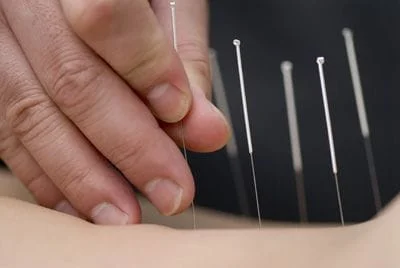Acupuncture Treatments

Acupuncture can be defined as the insertion of dry needles into the skin at specific locations called acupuncture points. Acupuncture is performed by certified practitioners and physicians to treat certain medical disorders. Depending on the training and experience of the practitioner and the problem being treated, acupuncture techniques may include electrical current through the needles (electro acupuncture) or heat (moxibustion) and pressure (acupressure).
Acupuncture began in China more than 2000 years ago. It is now practiced throughout the world, particularly in China, Korea and Japan. In the United States, acupuncture started gaining popularity in the early 1970s.
How Does Acupuncture Work?
The basic idea behind acupuncture, according to ancient theory, is that energy flows within the human body and can be stimulated to create balance and health. The energy flow (or vital force)—called qi and pronounced “chee”—moves throughout the body along 12 main channels known as meridians. These meridians represent the major organs and functions of the body although they do not follow the exact pathways of nerves or blood flow.
The goal of acupuncture is to correct imbalances of flow and restore health through stimulation, generally by inserting needles through the skin at points along the meridians of the body. Current acupuncture information lists up to 400 different acupuncture points for various health problems. Scientists have attempted to explain the actual physical effects of acupuncture on the human body. Some researchers suggest that pain relief happens when acupuncture needles stimulate nerves. Another well accepted theory is that acupuncture releases pain-relieving chemicals, such as endorphins and serotonin.
Acupuncture may also be effective because it targets painful tender points, sometimes called trigger points. Additionally, acupuncture may decrease pain-causing inflammation by stimulating the body’s pituitary gland to release cortisol, a hormone that is known to reduce inflammation. Although the exact manner in which acupuncture works is unknown, the treatment appears helpful for certain medical illnesses in certain people at certain times.
Will Acupuncture Relieve Your Back Pain?
A number of conditions, including back pain, are commonly treated with acupuncture (see below). Although some studies have shown that acupuncture has no benefit in relieving back pain,1,2 others have demonstrated a positive effect.3-6 A study published in 2006 demonstrated that acupuncture was effective in relieving pain in patients with chronic low back pain (pain lasting more than six months).7 It remains unclear and more research is needed to determine whether acupuncture helps people who have both back and leg pain, nerve pain or pain from spine fractures.
Acupuncture may help relieve your back pain. Depending on your back problem, your physician may recommend acupuncture either alone or in conjunction with other treatments, such as medications, physical therapy or exercise.
Conditions Commonly Treated with Acupuncture
- Chemotherapy-induced nausea and vomiting
- Tennis elbow
- myofascial pain
- low back pain
- postoperative dental pain
- fibromyalgia
- Osteoarthritis
- Neck pain
- carpal tunnel syndromes
- addiction
- smoking cessation
- stroke rehabilitation
- headache
- migraines
- menstrual cramps
- asthma
- plantar fasciitis
During the initial acupuncture session, the acupuncturist takes a thorough history and does a physical examination, including evaluation of the tongue, face and pulse. Some acupuncturists may ask about the patient’s diet to evaluate his or her nutritional well-being and may recommend changes possibly including herbal supplements. The first session is generally longer than follow-up appointments so that a treatment plan can be created for the specific conditions and complaints of each patient. During followup appointments, the acupuncturist reassesses the progress of the treatment plan and makes changes if needed. The initial evaluation may take up to 60 minutes with follow-up and maintenance appointments between 30-45 minutes.
Following each evaluation, the acupuncturist inserts needles at specific acupuncture points related to the patient’s complaints. Needle insertion causes very little pain; some patients describe a pinching, grabbing or tingling sensation. The needles are sterile and disposable and are not reused on other patients. This decreases the risk of spreading disease from patient to patient. The needles are removed at the end of the session. Depending on the practitioner’s skills and the condition being treated, other forms of acupuncture could also be used, such as moxibustion (acupuncture with heat) and acupressure techniques.
Six to 12 sessions and a few maintenance sessions throughout the year are generally an accepted treatment plan for a single complaint. Not everyone responds to acupuncture…it is reasonable to try two to three sessions per week for three to four weeks. If there is a good response you may want to continue. If there is minimal or no response, acupuncture may not help you at this time or you may need to try a different acupuncturist.
What Are the Risks of Acupuncture?
Acupuncture is a relatively safe treatment with minimal risks if done by a trained practitioner. Reasons for avoiding acupuncture may include bleeding disorders, taking medications that decrease clotting (blood thinning medications), pacemaker use, a skin infection in the area where the needle would be inserted or a systemic infection. Some acupuncturists will not perform acupuncture on pregnant women. Please notify the practitioner if you have any of the medical issues.
Possible Risks of Acupuncture
- infection
- bruising
- dizziness/lightheadedness
- infection
- sedation
- pain
- skin rashes
- minor bleeding
- lung trauma (rare)
- nerve injury (rare)
Reasons Acupuncture May Not Be Advised
- bleeding disorders
- blood thinning medications
- Pregnancy (1st trimester)
- Cardiac pacemaker
- Blood or skin infection
What Are the Costs of Acupuncture?
The cost of an acupuncture session varies by region and may depend on the specific techniques used by the practitioner. A typical session may range from $50.00–$100.00. Some insurance companies may provide limited coverage for acupuncture; you should verify your insurance coverage before the office visit.



